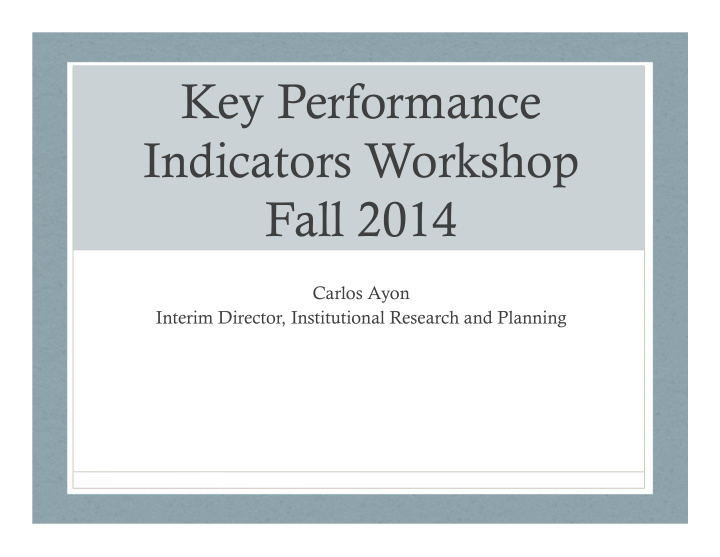



Key Performance Indicators Workshop Fall 2014 Carlos Ayon Interim Director, Institutional Research and Planning
Overview • KPI Overview • Discussing KPI Trends • Accessing Peer Institution Data
KPIs Course Information Sections Offered Courses Offered Student Information Majors New Majors Enrollments FTES WSCH Program Resources FTE Faculty Program Efficiency Ave Section Size Fill Rate (Census) WSCH per FTEF Program Outcomes Degrees Awarded Certificates Awarded Transfers Course Retention Rates Course Success Rates
KPIs – Course Information • Courses • Unique courses per term • Unique courses annually • Sections • Total number of sections offered per term • Total number of sections offered annually • Cross-listed courses counted once • If not cross-listed, distinction cannot be made.
KPIs – Student Information • Majors (Continuing) • New Majors • Enrollments • All course enrollments at Census • Full-time equivalent students (FTES) • As defined for apportionment • Weekly Student Contact Hours (WSCH) • WSCH = course contact hours * census enrollment
KPIs – Program Resources • FTEF • Total workload divided by contract workload • Includes load, overload, and adjuncts
KPIs – Program Efficiency • Average Section Size • Avg. Sections Size = census enrollments/# sections • Fill rate at Census • Number of enrollments at census divided by total number of seats available • Calculated by term and annually • WSCH/FTEF
KPIs – Program Outcomes • Degrees and Certificates Awarded • Transfers • Course Retention & Success Rates
KPIs – Discussing Trends • Most basic – increasing, decreasing, stable • Going Further • Relationships among indicators • Trends across related indicators • Decrease in sections, but an increase in WSCH and FTES • Higher fill rates, more courses with high WFCH • Connecting data with classroom experiences
Peer Data • CCCCO Datamart • Enrollments, Retention, and Success by TOP Code • Program Awards by TOP Code
Accessing Peer Data 1. datamart.cccco.edu 2. Highlight “Queries” and click “Outcomes” 3. Click “Retention/Success Rate” or “Program Awards” 4. Filter 1. Select State-District-College – “Collegewide Search” 2. Select District-College – Varies by peer institution 3. Select Term – varies 4. For “Program Awards” queries : Select Award Type – “Chancellors Office Approved” 5. Select Program Type – Varies For “Retention/Success Rate” queries: Select Instruction Method – 6. “All…”
Accessing Peer Data cont. 5. Click “View Report” 1. Data will populate in “Data & Format Area” 6. Add desired “Demographic Options”, “TOP Options”, or “Course Status” 7. Click “Update Report” 8. Click “Export to” and download/open report
Interpreting Peer Data • Program Award Data • Compare KPI data to peer institution degree and certificate data • Enrollment, and Retention and Success Rates • Peer institutional overall on the first line by course type • Ethnicity and Gender data • May need to add subgroup totals if data is available for “Delayed Interaction” and “Non Distance Education” • To do so, sum enrollment, retention, and success counts for individual subgroups • Divide retention count by enrollment count and success count by enrollment count to calculate rates.
Contact Information Carlos Ayon Interim Director Fullerton College Office of Institutional Research and Planning 321 East Chapman Avenue Fullerton, CA 92832-2095 OIRP Office: 714.992.7063 Direct: 714.732.5055 cayon@fullcoll.edu
Recommend
More recommend